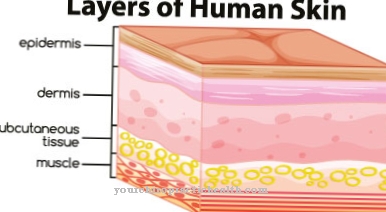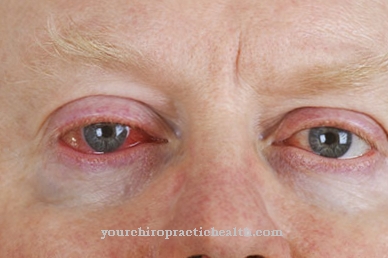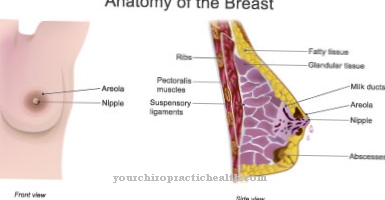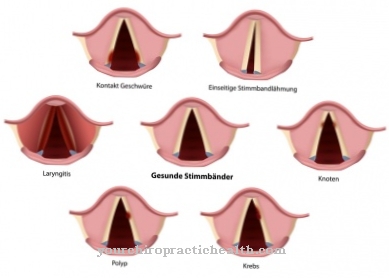A Hypervitaminosis is a vitamin poisoning. In most cases, the cause is abuse of dietary supplements. Even serious health disorders sometimes result from hypervitaminosis.
What is hypervitaminosis?

© kleberpicui - stock.adobe.com
Hypervitaminosis Doctors and nutritionists call a clinical picture that is based on an overdose of a vitamin.
Conceptually, hypervitaminosis is opposed to hypovitaminosis. These are vitamin deficiency symptoms. Avitaminosis is present if there is a complete lack of a vitamin in the diet. Hypervitaminoses are also called vitamin intoxications or vitamin poisoning. Doctors differentiate between an acute and a chronic form of the harmful vitamin excess.
Hypervitaminoses are mainly caused by lipophilic (fat-soluble) vitamins that can accumulate in the tissues of the body. The group of hydrophilic (water-soluble) vitamins is less of a consideration for symptoms of poisoning. The organism excretes these vital substances through the kidneys. Therefore, the hydrophilic vitamins are practically never responsible for hypervitaminoses.
causes
A Hypervitaminosis results in too high a vitamin intake. This almost always happens when patients have taken too many vitamin supplements. Other food supplements, which often contain vitamins as additives, can also be the cause.
But it is not always self-medication that causes a toxic excess of the otherwise vital vitamins. The doctor also uses vitamins therapeutically, which has also led to overdosing. Caution is also advisable in the clinical area, for example when patients need to be fed “artificially”. Gastric tube food contains a high proportion of vitamins and carries the risk of overdosing, especially if given for a long time.
The same applies to weeks of parenteral nutrition (infusion). A normal diet with common foods very rarely leads to hypervitaminosis. Only the consumption of excessive amounts of liver can lead to intoxication because of its high vitamin A content. The concentration of the vitamin is particularly high in the livers of arctic mammals. Therefore, the Inuit do not eat polar bear liver and thereby avoid hypervitaminosis.
Symptoms, ailments & signs
Hypervitaminosis can cause various symptoms and ailments, depending on its severity. In most cases, the poisoning causes gastrointestinal complaints, headaches and circulatory disorders. Those affected often vomit and also suffer from a loss of appetite, which in turn can cause deficiency symptoms. This can be accompanied by dizziness, incoordination and lethargy.
In the case of severe poisoning, visual disturbances such as double vision or blurred vision can occur. Outwardly, hypervitaminosis can be recognized by the torn corners of the mouth and the excessively pale skin. The skin damage can spread to the entire body and often leaves scars. The fingernails are often brittle and have light spots.
In general, hypervitaminosis severely limits the patient's quality of life. In the worst case, cardiac arrhythmias or a circulatory collapse occur. Furthermore, the pressure in the brain can increase, which can lead to restricted mobility and symptoms of paralysis. When the poisoning is treated, there are usually no other symptoms.
However, the detoxification represents an additional burden for the already weakened body. Hypervitaminosis usually occurs immediately after an overdose of vitamins or occurs over the course of several weeks to months.
Diagnosis & course
Acute Hypervitaminoses are not dissimilar to other poisonings in terms of symptoms. There are gastrointestinal complaints, headaches and circulatory disorders. The doctor will ask about the medication taken through a patient interview. This is how he can track down an overdose of dietary supplements and vitamin preparations.
Chronic vitamin intoxication is more difficult to unmask. For example, skin irritations or an enlarged liver are initially assigned to other diseases. The suspicion of chronic hypervitaminosis is often far removed here because the disease is relatively rare. This diagnosis problem is generally characteristic of the phenomenon. But eventually the doctor recognizes, for example, vitamin D intoxication based on targeted blood tests.
In addition to an increased concentration of the vitamin in the blood serum, the calcium concentration is also increased. This is critical because calcium is then missing in the bones. In the long term, there is a risk of osteoporosis (softening of the bones). Children can even suffer from growth disorders in the course of vitamin D hypervitaminosis. Even deaths have been reported.
Vitamin A hypervitaminoses are no less dangerous. In the initial stage, intoxication begins with headache and nausea and even vomiting. In the acute form, an increase in intercranial pressure (increase in intracranial pressure) can follow. Medical treatment is urgently required, otherwise there is a risk of brain damage from hypervitaminosis.
Complications
The abuse of supplements or other substances that contain many vitamins can lead to a relatively large number of complaints and complications. In most cases, hypervitaminosis is the primary cause of nausea and dizziness. The affected person vomits frequently and also suffers from anorexia. This can still lead to underweight.
It is not uncommon for hypervitaminosis to lead to impaired coordination and impaired concentration. The eyes can also be affected by the disease, leading to blurred vision or double vision. The corners of the mouth tear and are painful when eating. In general, the patient's quality of life is extremely reduced by the symptoms of hypervitaminosis.
In the worst case scenario, serious poisoning or circulatory disorders can occur. Furthermore, the pressure in the brain can also increase, which can lead to paralysis and restricted mobility. In most cases, there are no other complications in treating hypervitaminosis.
The symptoms go away on their own when the excessive supply of vitamins is stopped. If there is an acute emergency, medication can also be used to alleviate the symptoms. Life expectancy is not reduced by hypervitaminosis.
When should you go to the doctor?
In the case of hypervitaminosis, it is not necessary to see a doctor. If the overdose is minimal, it is often sufficient if enough water is consumed. In addition, the person concerned should take it easy and allow himself enough rest. If the symptoms disappear completely within a few hours, no further medical care is required. In the future, the consumption of vitamin preparations will have to be monitored more closely. If the hypervitaminosis is more pronounced, various symptoms of increasing intensity occur immediately after taking the preparations. A doctor's visit is necessary as treatment must be initiated. If vomiting, nausea, or dizziness occurs repeatedly, these signs should be presented to a doctor.
If you have diarrhea, cramps or pain, a doctor is needed. The use of other preparations should be stopped and pain killers should be avoided. Only in consultation with a doctor can it be clarified which medication should be used. Consult a doctor in the event of impaired coordination, attention problems or lethargy. If the person concerned suffers from insomnia, visual impairment or double vision, he or she needs medical help. If the corners of the mouth are torn, dry mouth or loss of appetite, a doctor should be consulted. In the event of an overdose over a long period of time, emotional problems, apathy or inner weakness arise. Fatigue and tiredness should also be clarified.
Doctors & therapists in your area
Treatment & Therapy
At Hypervitaminoses the doctor must first identify the cause of the overdose. It may not be easy to dissuade the patient from self-medication. Because vitamin preparations are now available as dietary supplements in every supermarket and are therefore risk-free.
In mild cases of acute hypervitaminosis, cessation of consumption is enough. If the symptoms are severe, the doctor may have to intervene with medication. In the case of vitamin D poisoning, therapy is aimed at lowering the calcium level with diuretic drugs.
Vitamin A hypervitaminosis is also addressed in a similar way. An increase in intercranial pressure must also be ruled out here, but possibly treated. An excess of vitamin C can cause digestive problems; kidney stones are also known as a result of this hypervitaminosis.
You can find your medication here
➔ Medicines against nausea and vomitingprevention
Hypervitaminoses For the consumer, prevention means to be careful with vitamin preparations. Particular attention should be paid to the amounts of vitamin A and D in the products concerned. As a rule, excessive consumption of liver will not occur, but the high vitamin A content may also have to be taken into account here. Those who take this to heart avoid hypervitaminoses.
Aftercare
Following a successfully treated hypervitaminosis, various follow-up measures are necessary. In the context of hypervitaminosis, patients suffer from numerous complaints that cause considerable stress on the organism. The body has to recover from these physical and psychological stresses after the illness.
For this reason, aftercare partly consists of taking physical rest for some time after completing the therapy. An essential part of the follow-up care is that the patient visits the doctor at regular intervals and has his blood values analyzed in a laboratory. The blood values of those vitamins that were responsible for the hypervitaminosis are particularly relevant.
The results of the analysis must be discussed by the doctor with the person concerned. In the course of this, the patient usually receives information about his diet and vitamin intake. Follow-up care also means that the person concerned looks for a professional nutritionist and has a menu drawn up by him.
Follow-up care for hypervitaminosis also includes measures to prevent a new disease. The patient's blood counts should be checked at close intervals for a few months after the illness and then in larger cycles. In addition, regular check-ups by the endocrinologist are useful in order to identify and treat any metabolic disorders in good time.
You can do that yourself
Hypervitaminosis does not always require medical treatment. Water-soluble vitamins can simply be rinsed out in the event of an overdose. Usually it is enough to drink enough water or diuretic teas.
In the case of vitamin D poisoning, the doctor should prescribe a light medicine to flush out the excess vitamins. In the case of mild hypervitaminosis, it is usually sufficient to reduce or discontinue consumption. In the event of an overdose of vitamin A, medical advice is required. Accompanying medical treatment, the patient should stay in bed for at least two to three days. A gentle diet, which should contain as little vitamin A as possible, supports recovery. A long-term change in diet protects against renewed hypervitaminosis and other complaints.
Various remedies from nature and the household help against the individual symptoms. Willow bark tea, for example, has proven itself as it reduces headaches and stimulates the appetite. Classic medicinal plants such as chamomile or lemon balm, also taken in the form of tea, capsules or dragees, help with nausea and vomiting. If the symptoms have not subsided after two to three days at the latest, the doctor must be informed. It is best to refrain from further self-help measures.

















.jpg)



.jpg)

.jpg)




